
Acupuncture alleviates diabetic peripheral neuropathy (DPN), quantified in modern research. Researchers from Weifang People's Hospital of Fangzi District conducted a clinical trial and analyzed the effects of two treatment protocols. The results show that the integral approach of combining acupuncture with routine pharmaceutical care outperformed pharmaceutical monotherapy. [1]
Measurement parameters in the study involved sensory nerve conduction velocity (SCV), motor nerve conduction velocity (MCV), total score of clinical symptoms, and the MDNS score. Blood glucose index, including fasting plasma glucose, 2-hour (2 hPG) glucose and glycosylated hemoglobin (HbA1c) was also recorded and analyzed. Upon completion of the treatment, nerve conduction velocity and symptom scores presented more marked improvements in the integrated medicine group, with a total efficacy rate of 97.78%. The rate for the regular care group involving drug monotherapy was 84.44%. The results indicate that acupuncture added to standard care improves patient outcomes.
The study used a sample of 90 cases admitted to the hospital. The patients were randomized into an integral treatment group and a drug monotherapy group, with 45 cases in each group. The baselines prior to the investigation were as follows. The drug control group consisted of 25 males and 20 females. Age range was 43 to 80 years. Average age was 62.63 ±4.14 years. Course of condition was one to ten years. Mean course of condition was 5.20 ±1.21 years. The integral treatment group consisted of 23 males and 22 females. Age range was 42 to 81 years. Average age was 61.82 ±4.05 years. Course of condition was two to ten years. Mean course of condition was 5.30 ±1.18 years.
The two groups were both provided with routine care, including regular exercise and diet management. The drug monotherapy group was administered 0.5 mg mecobalamine intramuscularly or orally. Plus, 20 ml thioctic acid injection was diluted in 250 ml sodium chloride injection and administered intravenously. Patients underwent two-week treatment in total. The integral group received manual acupuncture in addition to the above treatment protocol. Main acupoints included the following:
- CV4 (Guanyuan)
- SP10 (Xuehai)
- BL20 (Pishu)
- SP6 (Sanyinjiao)
- BL18 (Ganshu)
- BL23 (Shenshu)
Supplementary points were selected according to the affected area. For patients with symptoms of pain or numbness in the palms, EX-UE9 (Baxie) and EX-UE20 (Shixuan) were used. For those with pain in the forearms or upper arms, PC6 (Neiguan), TB5 (Waiguan), LI10 (Shousanli), LI4 (Hegu), and LI11 (Quchi) were used. For those with pain in the soles of the feet and toes, LV3 (Taichong) and KD3 (Taixi) were used. For numbness and pain in the lower limbs, ST40 (Fenglong), GB39 (Xuanzhong), GB34 (Yanglingquan), ST36 (Zusanli), KI16 (Zhaohai), and SP9 (Yinlingquan) were used.
For Shenshu, needles were perpendicularly inserted and manipulated clockwise. For Pishu, needles were obliquely inserted and manipulated clockwise. The rest of the points all received a mild reinforcing-attenuating method and the needles were manipulated every ten minutes. Moxa was ignited to apply heat to the skin surface using a circling moxibustion approach. Needle retention time was 30 minutes. The needling treatment was performed on alternate days for two weeks. Acupuncture increased the outcome rate from 84.44% to 97.78%, indicating improved outcomes for diabetic peripheral neuropathy patients.
Reference:
[1] Deng Qiao, Chen Chao, Yu Lina, Discussion on the Treatment of Patients with Diabetic Peripheral Neuropathy by Acupuncture Combined with Conventional Western Medicine , Diabetes New World, May 2022, 1672-4062 (2022) 05a-0165-04.


